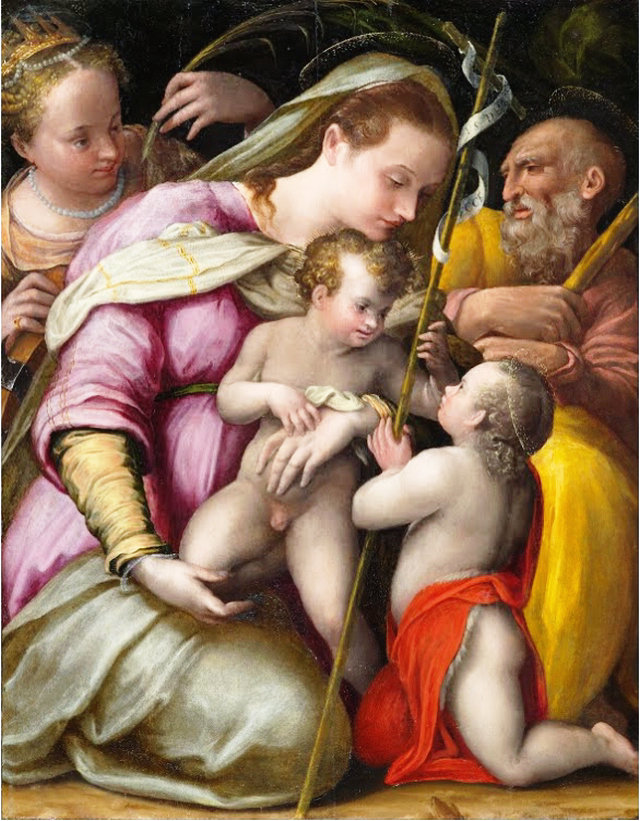Prospero Fontana


Prospero Fontana (Bologna, 1512 – 1597), was an Italian painter of the late Renaissance. He is best known Mannerist style, which in calculated composition, well-studied in circular rhythms that bind figures in a unitary development, is embellished with ornaments and refinements: finely-woven fabrics, veils, pearl threads, and finest embroidery. His daughter, Lavinia Fontana, was also a prominent painter.
After a prolonged “practiced” as assistant to various Mannerist painters, Prospero Fontana opened a school in Bologna that had a significant role in the maturation of Emilian painting in the second half of the 16th century. At the end of his career, however, he was literally eclipsed by his cousins Carracci who had formed right in his school. Fountain was an excellent portraitist (skill that he conveyed to his daughter Lavinia) and as such was presented by Michelangelo to Julius III, becoming one of the favorite pittores of the pontiff, “who saluted him amongst palatine painters. He also served the three successors of Giulio and was considered among the “best portrayers of his time.”
Disciple of Innocent of Imola (from which he will be chosen to die to finish his canvas), little more than sixteen-year-old Fontana was among the aides of Perin del Vaga, a pupil of Raffaello, in the decoration of Palazzo Doria in Genoa He worked, albeit discontinuously, for almost a decade.
Around 1550 he began working for Julius III in Rome, where, among other things, he oversaw the decoration of the Belvedere in the Vatican; Worked in Castel Sant’Angelo; He decorated, together with Taddeo Zuccari, Villa Giulia and frescoed the palace of Palazzo Firenze in Campo Marzio (then belonging to the Pope’s brother).
Towards 1560 he went to France, one of the various Mannerist painters involved by Primaticcio in what would be the founding of the School of Fontainebleau, an experience that even for Fontana was very formative. The French stay, however, was short, because Fontana, severely ill, had to be repatriated quickly (unable to even earn the advance received that Primaticcio then condoned).
Shortly after, Fontana accompanies Vasari (with whom he has already worked in Rimini) in Florence, where he co-works with Livio Agresti in fresco Palazzo Vecchio (1563-1565), where he is admitted to the Fiorentina Academy of Design.
Returning to Bologna in 1570, he left for the following year for Città di Castello, where he had been commissioned to decorate Palazzo Vitelli in Sant’Egidio. The work involved it with help from 1572 to 1574, but its central part, the 22 scenes of the Stories of Vitals in the Salon, is often cited for the speed with which it was executed (a few weeks).
From Città di Castello Fontana finally returned to Bologna where, however, he had continuously worked in the intervals between the various other works. In 1550 he painted the Palazzina della Viola (Scenes of the Life of Constantine), in 1551 Palazzo Bocchi (frescoes of Virtues and Gods), between 1550 and 1556 Palazzo Poggi (Scenes of Moses’ life in its hall and various other Frescoes in other rooms); In 1560 he painted the Dispute of St. Catherine for the sanctuary of the Madonna del Baraccano (“which is a very good work,” wrote Vasari); Between 1566 and 1568 he had frescoed the Pepoli chapel in San Domenico and in 1570 participated in the decoration of the new apse in the Church of St. Peter.
Fontana continued to paint until 1590, but in the last period it remained “without commissions and without followers.” According to Abbot Luigi Lanzi, who attributed to the Fountain a profound decay of painting in the upper center, this had to be done, before the competition of the Carracci, to his too hasty and poorly painted painting (overly borrowed by Vasari) for a thirst for Gains associated with a loose “love of luxury.”